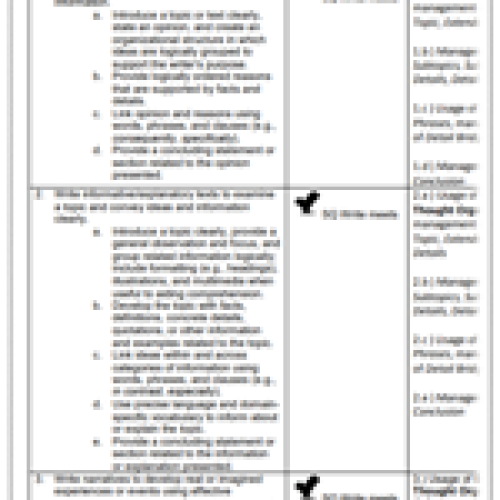Read about •SQ Write Overview •SQ Write Materials •SQ Write Process •SQ Write and Executive Functioning •SQ Write for Language Learning Disabilities •SQ Write and Executive Functioning for ADHD
SQ Write Overview
Finally an end to “I don’t know what to write!” SQ Write is a simple yet powerful process that significantly improves essay writing skills. SQ Write can be used by elementary, middle, high school and even college age students. Poor writers can become great, self-reliant producers of high-quality content.
Are you tired of the same-old writing programs and worn out graphic organizers? It’s time for a fresh, innovative approach! SQ Write finally addresses the question “How can I teach my students to become more confident, self-reliant writers?” The solution is in the research! In order for students to become good writers, they must first be good thinkers. Good thinkers ask good questions, and then generate the answers. That’s the beauty of SQ Write – this curriculum utilizes an innovative, brain-based, Self-Questioning technique that provides an easy way for students to generate their own ideas, beginning with a few simple questions!


SQ Write is a comprehensive curriculum that applies an executive functioning approach to both learning and teaching how to write effectively. These executive functioning skills are invaluable because they become a part of the student’s repertoire for managing writing tasks across all subject areas. Better yet, students will take these skills far beyond the classroom and apply them later in the real world.SQ Write employs a simple, yet powerful process that can be used in all tiers of instruction to help students in grades 4 through high school become self-reliant writers who not only meet the Common Core Standards, but create high-quality, organized writing. Teachers can also use SQ Write to provide differentiated writing interventions in the general education curriculum and all tiers of instruction as mandated by the RTI process of the IDEA act.
SQ Write Materials
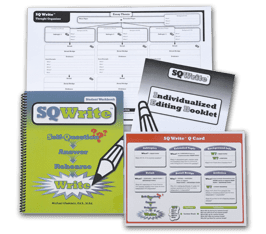
SQ Write Teacher Guide
SQ Write is a comprehensive curriculum that applies an executive functioning approach to both learning and teaching how to write effectively. These executive functioning skills are invaluable because they become a part of the student’s repertoire for managing writing tasks across all subject areas. Better yet, students will take these skills far beyond the classroom and apply them later in the real world.SQ Write employs a simple, yet powerful process that can be used in all tiers of instruction to help students in grades 4 through high school become self-reliant writers who not only meet the Common Core Standards, but create high-quality, organized writing. Teachers can also use SQ Write to provide differentiated writing interventions in the general education curriculum and all tiers of instruction as mandated by the RTI process of the IDEA act.
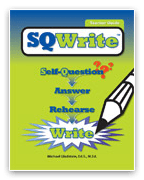
Thought Organizers
Thought Organizers graphically present structures and outlines
Supplemental blank Thought Organizers (may be ordered)
- In packs of 50, size 11” x 17”
- As a 2’ x 3’ poster for class demonstrations
Thought Organizers provide a visual record of student’s ideas as they move through the SQ Write curriculum. It also provides a space to easily record new ideas with previously recalled ideas, while decreasing working memory loads.
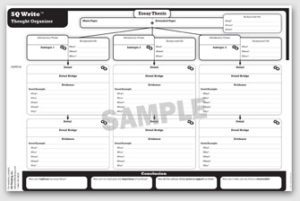
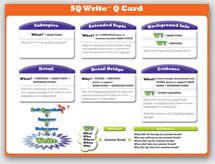
Q Card
The Q Card provides prompts to help students formulate self-questions at strategically placed points in the Thought Organizer. Continual use of the Q Card throughout the SQ Write curriculum enables students to eventually internalize the steps in formulating the self-questions necessary to create high-quality written work.
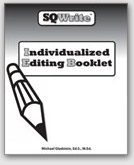
Individualized Editing Booklet (IEB)
The Individualized Editing Booklet (IEB) helps students to remember specific writing rules related to spelling, grammar, and punctuation using the student’s own writing samples. Students can record corrections from previous corrected writing assignments. The student can then easily refer to the IEB to recall correct spelling of words and rules of grammar so that prior mechanical errors can be avoided.
SQ Write Process
The Q Card provides prompts for students to formulate the right questions to generate the novel answers and ideas necessary for an effective essay. Then, using the SQ Write Thought Organizer, students are able to capture these ideas, visually storing them until they are ready to be put to paper. With the ideas organized and written down, students can read their ideas aloud to make sure they sound “right”. Finally, they will be ready to write organized, structured essays – every time!
With SQ Write, students apply this unique self-questioning process to generate ideas and answers. They record these results on the SQ Write Thought Organizer, which reduces their working memory load while providing a handy resource for them to keep their ideas organized and easy to reference. From there, students form their ideas and answers into complete sentences simply by reciting the ideas they have written down on the Thought Organizer. As they rehearse these ideas aloud, they are naturally able to create and write fluid sentences. This rehearsal is akin to creating a rough draft, before the student even puts pen to paper. The results are detailed and organized essays- every time!
SQ Write and Executive Functioning
SQ Write teaches thinking and questioning skills (executive functioning). SQ Write teaches students how to apply executive functioning – or thinking and questioning skills — to create logical, well-constructed essays through the use engaging real life activities. These activities employ the metacognitive strategies of self-questioning, whole-to-part analysis, and verbal mediation and rehearsal.
Self-Questioning is a technique used to access prior knowledge that leads students to become self-reliant thinkers and writers. The ability to independently generate self-questions allows for an indefinite amount of knowledge to be accessed for writing content.
Whole-to-Part Analysis breaks broad ideas into manageable chunks. Students find it easier to work with smaller parts — this increases their initiation while minimizing their desire to procrastinate.
Verbal Mediation and Rehearsal directly influence the development of written expression. Most students can more effectively organize information orally. With SQ Write, students speak their ideas aloud until they sound “right.” By rephrasing their ideas, students refine their rough drafts, even before beginning to write!



SQ Write for Language/Learning Disabilities
SQ Write creates a framework, reviews critical steps and provides feedback.Writing is one of the most difficult academic skills to learn. Anyone who has composed a paragraph or a composition can attest to the heavy thinking load. Idea generation, breaking ideas into smaller parts, writing with complex sentences, spelling, grammar, organization – together, all of these processes can seem quite daunting.
Results from the National Center for Educational Statistics (2008) confirm these writing challenges. In fact, only 28% of fourth graders, 33% of eighth graders, and 24% of twelfth graders write at or above a proficient level. Further, only 2% of eighth graders write at an advanced level. If the general population of students is struggling to write, imagine the challenges for students with language/learning disabilities.
Gersten & Baker (1999) conducted a meta-analysis on research-based instructional approaches for teaching written expression to students with learning disabilities. Three specific instructional requirements stood out that consistently led to improved student performance in teaching writing to students with learning disabilities.
- Utilize a basic framework for planning, writing, and revision.
- Explicitly teach critical steps in the writing process.
- Provide feedback from the information explicitly taught.
The table below demonstrates how SQ Write meets these requirements.
| Research says to include | SQ Write Applies the Research |
|---|---|
| 1. Utilize a basic framework for planning, writing, and revision. | SQ Write employs a simple, yet powerful process used in all tiers of instruction: The Thought Organizer keeps students on a predetermined writing path. This path is the specific scope and sequence in essay building.The Q Card provides question prompts to help students formulate self-questions at strategically placed points in the Thought Organizer. Students consistently and independently generate ideas through self-questioning. Verbal rehearsal of the Thought Organizer are verbal rough drafts. The verbal rehearsal provides students with auditory feedback resulting in revisions occurring prior to even writing. After repeated verbal drafts, students easily write these thoughts down on paper adhering to the Thought Organizer sequence. |
| 2. Explicitly teach critical steps in the writing process. | In the Skill-Building section, students are explicitly taught the precursor writing skills of self-questioning and whole-to-part analysis. Then, students apply these skills to build their essays.Each chapter adds explicit essay building instruction for each new component of the Thought Organizer, or essay. |
| 3. Provide feedback from the information explicitly taught. | Each lesson begins with teacher-led instruction utilizing feedback/teacher insights for scaffolding followed by an individualized lesson. Verbal rehearsal provides immediate auditory feedback prompting students to revise their verbal essay.When writing, each essay component is listed with a corresponding check box at the top of the Essay Worksheet. Students self-monitor these boxes to be sure they include all the necessary components of each paragraph and essay. |
SQ Write and Executive Functioning for ADHD
Many times ADHD and poor executive functioning skills are simultaneously present. Research indicates that ADHD adversely impacts the brain’s executive functioning. When operating effectively, our executive functioning skills allow us to effectively think, plan, organize, prioritize, and monitor our ideas, thoughts and actions. These are exactly the skills that research suggests are required to be an effective writer.
If your student or child is diagnosed with ADHD or more subtle attentional problems, it is likely their executive functioning skills are compromised. Studies clearly demonstrate that writing difficulties are the most common academic deficit area by students diagnosed with A.D.H.D. (Mayes & Calhoun, 2005). Since writing is an organizational, or executive functioning task, students diagnosed with ADHD can benefit greatly from writing instruction that directly addresses the application of executive functioning skills in the writing process. SQ Write fills this need, and students with ADHD find SQ Write to be the right program for their brain.


